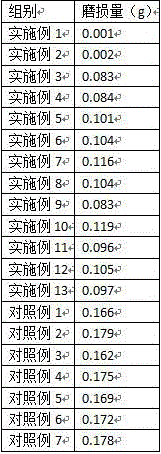Nanoscale compound wear-resisting brake pad
A brake pad, nano-level technology, applied in the field of brake system, can solve the problems of high price, brake fluid boiling, brake shrinkage, etc., and achieve the effects of high wear resistance, good friction reduction and wear resistance, and high thermal stability.
- Summary
- Abstract
- Description
- Claims
- Application Information
AI Technical Summary
Problems solved by technology
Method used
Image
Examples
Embodiment 1
[0019] Example 1 A sample with a mass ratio of carbon nanotubes to phenolic-based activated carbon fibers of 1:5 was prepared. 10 parts of carbon nanotubes, 50 parts of phenolic-based activated carbon fiber materials, 15 parts of polyphenylene sulfide, 15 parts of EPDM rubber, 20 parts of coal gangue powder, 5 parts of zinc oxide, 5 parts of silicon dioxide, 100 parts of 5% NaOH solution, 100 parts of 95% ethylene nitrile solution, 100 parts of 0.1% H 2 o 2 acetone solution, 200 parts deionized water.
[0020] Step 1, first carbon nanotubes, polyphenylene sulfide, zinc oxide, silicon dioxide, EPDM rubber, coal gangue powder in nitrogen
[0021] Under purge for 3h, the gas flow rate is 100ml / min;
[0022] Step 2. Vibrate the above-mentioned materials carbon nanotubes, polyphenylene sulfide, zinc oxide, and EPDM under ultrasonic waves for three hours;
[0023] Step 3. Add 15 parts of polyphenylene sulfide and 10 parts of carbon nanotubes into the flask, then add 200 parts of...
Embodiment 2
[0031] Example 2 A sample with a mass ratio of carbon nanotubes to phenolic-based activated carbon fibers of 5:1 was prepared. 50 parts of carbon nanotubes, 10 parts of phenolic-based activated carbon fiber materials, and other raw materials, the operation steps are the same as in Example 1.
Embodiment 3
[0032] Example 3 A sample with a mass ratio of carbon nanotubes to phenolic-based activated carbon fibers of 1:1 was prepared. 10 parts of carbon nanotubes, 10 parts of phenolic-based activated carbon fiber materials, and other raw materials, the operation steps are the same as in Example 1.
PUM
 Login to View More
Login to View More Abstract
Description
Claims
Application Information
 Login to View More
Login to View More - R&D
- Intellectual Property
- Life Sciences
- Materials
- Tech Scout
- Unparalleled Data Quality
- Higher Quality Content
- 60% Fewer Hallucinations
Browse by: Latest US Patents, China's latest patents, Technical Efficacy Thesaurus, Application Domain, Technology Topic, Popular Technical Reports.
© 2025 PatSnap. All rights reserved.Legal|Privacy policy|Modern Slavery Act Transparency Statement|Sitemap|About US| Contact US: help@patsnap.com

